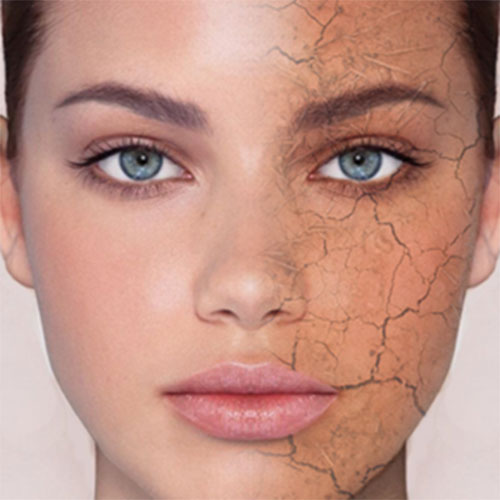Understanding your skin is one of the most essential steps in achieving a healthy and glowing complexion. With the overwhelming number of skincare products and routines out there, knowing your skin type can be the difference between a radiant glow and constant skin troubles. Dermatologists classify skin into five basic skin types: normal, dry, oily, combination, and sensitive. Each has distinct characteristics, challenges, and care requirements. In this article, we will explore these skin types in depth, helping you identify your own and tailor your skincare routine accordingly.

1. Normal Skin Type

The normal skin type is often considered the “ideal” between the basic five skin types. It is okay-balanced — not overly oily and not too dry. People with this skin type typically have small pores, few imperfections, and a healthy, even tone. They rarely experience breakouts or excessive dryness and can tolerate most products without irritation.
Key Characteristics:
- Smooth texture
- Minimal sensitivity
- Few to no blemishes
- Balanced oil and moisture levels
Care Tips: If you have normal skin, you’re considered lucky. Maintenance is relatively simple. Use gentle cleansers, regular moisturizers, and sunscreen. However, avoid overly harsh treatments that could disrupt the natural balance.
2. Dry Skin Type

Dry skin is frequently misunderstood and can feel tight, rough, and sometimes itchy. People with dry skin may notice flaking or red patches, especially during colder months or after washing their face. This type lacks sufficient moisture and natural oils, leading to compromised skin barrier function.
Key Characteristics:
- Tight or rough texture
- Visible flaking or scaling
- Dull complexion
- Prone to irritation
Care Tips: Hydration is your best friend. Apply nourishing moisturizers that include ingredients such as hyaluronic acid, ceramides, and glycerin. Avoid hot showers and harsh soaps. Gentle, creamy cleansers are preferable over foaming ones.
3. Oily Skin Type

Oily skin is characterized by an overproduction of sebum, which leads to enlarged pores, a shiny appearance, and a higher probability of acne and blackheads. While it can be frustrating to deal with, oily skin has a silver lining — it’s usually less prone to wrinkles and signs of aging.
Key Characteristics:
- Shiny or greasy appearance
- Enlarged pores
- Frequent acne or blackheads
- Makeup may slide off easily
Care Tips: Choose oil-free and non-comedogenic products. Gel-based cleansers and lightweight moisturizers work best. Ingredients like salicylic acid, niacinamide, and clay can help control oil production without over-drying the skin.
4. Combination Skin Type

Combination skin is a blend of both oily and dry skin types, making it one of the most common and tricky to manage. The T-zone—which possesses the forehead, nose, and chin—tends to be oily, while the cheeks are usually dry or normal. This type requires a balanced approach to skincare.
Key Characteristics:
- Oily T-zone with dry/normal cheeks
- Enlarged pores in certain areas
- Occasional breakouts
- Fluctuating skin texture
Care Tips: Use a gentle cleanser suitable for all skin types, and apply targeted treatments to specific areas. For example, use a mattifying product on the T-zone and a hydrating cream on the cheeks. Avoid products that are too drying or too heavy.
5. Sensitive Skin Type

Of all skin types, sensitive skin reacts the most strongly.. It tends to flush easily and may burn or sting when exposed to new skincare products, environmental factors, or even stress. Redness, itching, and inflammation are common complaints.
Key Characteristics:
- Redness or blotchiness
- Burning, stinging, or itching
- Frequent irritation
- Reacts strongly to new products
Care Tips: Opt for hypoallergenic, fragrance-free skincare products. Look for calming ingredients such as aloe vera, chamomile, and colloidal oatmeal. Always patch-test new products before applying them to your entire face.
Why Knowing Your Skin Type Matters
Knowing your skin type is not just about choosing the right cleanser or moisturizer — it’s about understanding how your skin behaves and reacts. Skincare is not one-size-fits-all, and what works for one person might be ineffective or even harmful for another. Misidentifying your skin type can lead to using the wrong products, which can cause breakouts, dryness, or sensitivity.
Additionally, skin types can change over time due to age, climate, diet, stress, and hormones. What was once oily skin in your teenage years might become dry or sensitive in adulthood. Therefore, reassessing your skin type periodically is crucial.
To Conclude
The journey to flawless skin starts with recognizing the five basic skin types: normal, dry, oily, combination, and sensitive. Each has its own strengths and challenges, but with the right knowledge, anyone can develop a routine that suits their specific needs. Whether you’re battling oiliness or trying to calm sensitivity, there’s a solution tailored to your skin type.
Remember, healthy skin is not about perfection—it’s about balance. So, take the time to listen to your skin, observe how it reacts, and choose products that support its unique nature. With consistent care and a personalized approach, radiant skin is well within your reach.
